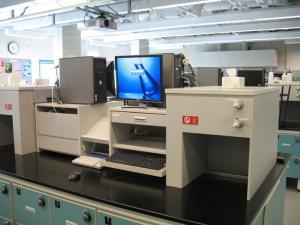Facilities
Chemistry Facilities
The Chemistry Building was completed in June of 1993 after a two year period of construction. The Department moved in during Summer 1993 and began classes in September. Two features of the 64,000 square foot building emphasized in the design are the availability of natural light in all laboratories and major corridors, and the availability of "human spaces" where students can study within the building or get together for impromptu discussions with each other and with their professors. The general plan of this building is based on a two corridor system. One of these is a service corridor which is located on each floor in the center of the building and divides it into two halves. A supply elevator serves these corridors, and it connects to the stockroom on the first floor of the building. All teaching functions are located on the East side of this corridor, major instrumentation and research functions are located on the other side. All of the lab preparation/supply rooms, and all of the research labs, are located on the supply corridor. The second corridor, which is on the front of the building on each floor, is a public corridor. All of the teaching labs are located on this public corridor. Students also use it to reach their instructional labs. Faculty offices are located in a stack (6 offices on each floor) located at the north end of the building.
Networks
The chemistry department has four major networks within the chemistry building:
-
A faculty/staff network with 25 workstations.
-
A student computer classroom with 22 workstations.
-
Laboratories with 80 workstations total.
-
A UNIX network in the student computer classroom with 4 UNIX workstations.

Chemistry Student Computer Lab (CB385)
This student computer classroom has 22 IBM-compatible 350 MHz Pentium II stations and 4 Silicon Graphics Indigo2 XZ UNIX-based workstations. The IBM stations are available to all chemistry students, while the SGI stations require an application for a personal account or an assigned class use. Room 280 is open during the day, with upper division students gaining evening and weekend use through the use of card-key access.
The IBM stations use WinNT and have a wide variety of software available. A partial list of the software includes:
-
MS Office (Word, Excel, Access, Power Point)
-
Origin 5.0 (technical graphing)
-
Alchemy III (molecular modeling - mechanics)
-
PC Spartan Pro (ab initio and semiempirical calculations)
-
Isis/Draw 2.1 (chemical structure drawing)
-
ChemWindow and ChemWeb 3.1
-
Organic Nomenclature (tutorial)
-
SpectraBook I and II (nmr,cmr,ir,ms)
-
Spectral Interpretation
-
IR Tutor
-
Tools of Chemistry (sig figs, exponents, dimensional analysis)
-
Concepts of Chemistry (mole concept, stoichiometry, ionic reactions, oxidation/reduction, ionic equilibrium)
-
Lewis Diagrams
-
Comprehensive Chemistry (CD-ROM)
-
Labworks (data collection spreadsheet)
-
WinQual (inorganic qualitative analysis)
-
Periodic Table
-
SQUALOR (qualitative organic)
-
Varian GC-MS Software
-
Racoon (nmr simulation)
-
Varian AAS Software
-
Xwin server for use of UNIX workstations
-
NMR Tutor *Chem Draw Pro 4.5
-
Raswin
The Silicon Graphics stations are used primarily for molecular modeling and computational chemistry (Sybyl, MM2, MM3, ab initio, density functional and semiempirical methods) and have the following software:
-
SPARTAN
-
BioSym InsightII and Discover
-
CeriusII (solid state modeling)
-
XMosaic
-
A variety of other utility programs
Teaching Laboratories
Rooms 210 and 220 are general chemistry laboratories each holding 24 students. These labs each have 12 networked computer stations, one per pair of students. These computers have an interface module and software (Vernier Lab Pro) that allows students to collect pH, conductivity, temperature, pressure, and optical absorption data and place it directly into a spreadsheet for manipulation and graphing. A number of different types of scientific software are available on these stations, including ChemDraw and Origin.
Room 330 is the analytical chemistry laboratory holding 32 students. This lab has 16 networked computer stations, one per pair of students. It has the same interfacing equipment and software as is found in the general chemistry laboratories, which allows students to collect pH, conductivity, temperature, pressure, and optical absorption data and place it directly into a spreadsheet for manipulation and graphing.
-
500 MHz FT-NMR
-
300 MHz FT-NMR
-
GC-MS with EI/CI and MS/MS
-
5 Gas Chromatographs
-
4 FT-IR Spectrophotometers
-
6 Diode Array UV/Visible Spectrophotometers
-
Circular Dichroism Spectrometer
-
Atomic Force Microscope
-
Scanning Tunneling Microscope
-
Raman Microspectrometer
-
Flame Atomic Absorption Spectrometer
-
Graphite Furnace Atomic Absorption Spectrometer
-
Spectrofluorometer with Temperature Control, Anisotropy, and Autotitration Accessories
-
HPLC Dual Pump System with UV/Vis and Refractive Index Detectors
-
Voltammetric Analyzer
-
Preparative-Scale MPLC
-
Radial Chromatograph
-
2 Pulse Chemisorb Instruments
-
2 Controlled Atmosphere Glove Boxes
-
Cryogenic Refrigerator
-
Isoperibol Bomb Calorimeter
-
2 Photochemical Irradiation Systems
-
Magnetic Susceptibility Balance
-
Microwave Synthesizer System
-
3 Ultracentrifuges
Complete Listing of Instrumentation (pdf file)
Other services and instruments are available through Western's Scientific Technical Services include:
-
Scanning Electron Microscope with EDX accessory
-
HPLC with Electrospray Ionization/Mass Spectrometer Interface (HPLC-ESI-MS)
-
Inductively Coupled Plasma Mass Spectrometer (ICP-MS)
-
Ion Chromatograph (IC)
-
Liquid Scintillation Counter
-
Electronic and Machine Shop Support
